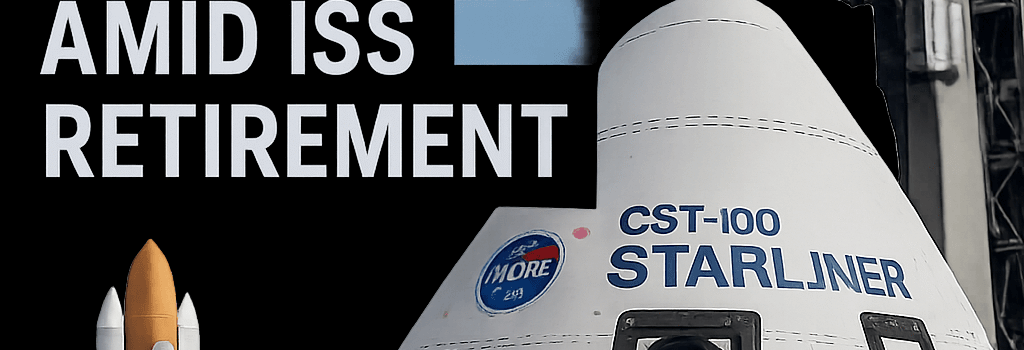NASA Doubles Down on Starliner Amid ISS Retirement

Options Are Good
More than a decade after Boeing and NASA first announced the CST-100 Starliner program, the spacecraft is still grounded by a series of engineering setbacks. Yet NASA’s Commercial Crew Program manager, Steve Stich, stresses the strategic need to keep Boeing’s Starliner in the game—including fresh propulsion upgrades, leak-proofing measures, and thermal enhancements—even as the International Space Station (ISS) nears its planned 2030 deorbit.
Starliner’s Technical Troubles and Ongoing Remedies
Propulsion System Overhaul
Starliner’s service module uses 28 Aerojet Rocketdyne-built mono-propellant thrusters, each generating 100 N of thrust via hydrazine decomposition. During the December 2024 Crew Flight Test, several thrusters experienced intermittent thermal run-up above 150 °C—exceeding their 120 °C design limit—and three suffered minor valve seat erosion due to helium purge leaks. Boeing engineers have since:
- Replaced PTFE-backed lip seals with nickel-infused Grafoil® composite seals to cut leak rates from 1×10−5 to below 1×10−7 std cc/s.
- Added multi-layer thermal shunts and phase-change heat spreaders around thruster manifolds to maintain temperatures within a 50 °C–90 °C window.
- Reinforced the pyrotechnic isolation valves with titanium mesh filters to trap particulate debris and prevent valve jamming.
Structural and Aerodynamic Refinements
In 2013, wind-tunnel tests at NASA’s Ames Research Center uncovered unexpected vortex shedding at Mach 0.8 around Starliner’s midbody. Boeing’s solution—an aerodynamic skirt extension adding 0.6 m2 of forward-facing surface area—reduced fluctuating loads by 30%. Today, adapting Starliner for ULA’s forthcoming Vulcan Centaur rocket entails recalculating shear forces at the 5 g launch acceleration and re-validating the composite fairing interface under random vibration up to 30 grms.
“We know precisely where the margin was and how much reinforcement is needed,” says Aerojet Rocketdyne propulsion lead Dr. Karen Montoya. “The current test campaign simulates over 200 hot-fire cycles to ensure zero leaks and stable thrust profiles.”
Mission Profile: Cargo, Crew, and Beyond
NASA has not finalized whether Starliner’s next flight—currently targeting Q1 2026—will carry a crew or cargo. While crewed missions require a full qualification of life-support systems, launch abort sequences, and acoustic loads below 145 dB, an all-cargo flight can proceed once technical mitigations are validated in a Pathfinder Test Flight (PTF). That approach mimics SpaceX’s inaugural Dragon missions, which flew several cargo runs (CRS-1 through CRS-4) before taking astronauts to the ISS in 2020.
However, dedicating an Atlas V booster to cargo consumes one of ULA’s remaining five 402-class vehicles. If Boeing switches to Vulcan, they must retrofit the Standard Payload Adapter (SPA) and ensure the composite-matrix fairing meets NASA’s 1×10−6 Pa leak-rate requirement.
NASA’s “Dissimilar Redundancy” Mandate
With SpaceX’s Crew Dragon exceeding reliability targets—11 successful astronaut flights and zero inflight aborts—NASA could, in principle, rely solely on Dragon for ISS rotations until 2030. But the agency’s core philosophy of “dissimilar redundancy” demands two independent providers to mitigate systemic risk. As Stich explains:
“Should Dragon encounter a systemic software bug or an abort system anomaly, having Starliner ready ensures uninterrupted access to low-Earth orbit.”
Additional Deep-Dive Analyses
1. Launch Vehicle Transition: Atlas V vs. Vulcan
Switching Starliner from Atlas V to Vulcan Centaur involves:
- Redesigning the forward attach ring to handle 5% higher axial compression loads during max-Q.
- Requalifying the Integrated Vehicle Electronics (IVE) power bus against Vulcan’s unique Pogo oscillation signature at 15 Hz.
- Updating thermal protection for the interstage adapter, where radiative heating peaks near T+200 s during second-stage ignition.
2. Commercial LEO Architecture Post-2030
NASA’s LEO commercialization strategy envisions privately built platforms—Axiom Station, Blue Origin’s Orbital Reef, Voyager’s Starlab. Yet these outposts require guaranteed crew and cargo delivery. By transferring unused Starliner task orders post-ISS to commercial stations, NASA offers developers an anchor tenant boost. Without such guarantees, investors may hesitate to fund laboratories that cost upwards of $1 billion to launch and outfit.
3. Risk Assessment & Lifecycle Cost
Space industry analysts estimate Starliner’s per-seat price at ~$90 million—10% above Crew Dragon’s current $81 million rate. But spreading development costs across six missions could reduce unit costs by 15%. NASA’s GAO-mandated lifecycle cost analysis weighs these savings against potential technical delays, recommending a “go/no-go” decision for ATP-4 (Authority to Proceed) by mid-2026.
Looking Ahead
As the ISS edges toward retirement, NASA must decide: extend Dragon’s certification to eight-month missions, accelerate Starliner’s operational debut, or reallocate funds to commercial LEO stations. With congressional budget pressures aiming for “minimal safe operations” and a 25% cut in NASA’s overall appropriation for FY 2026, every seat counts.
Ultimately, whether Starliner takes astronauts back to Earth—or inflation-adjusted dollars flow instead to Axiom or Orbital Reef—depends on Boeing’s ability to clear final integrated hot-fire tests and on NASA’s dedication to maintaining two on-ramps to space. For now, both federal stakeholders and private investors will watch Boeing’s next propulsion test campaign closely. Success could secure Starliner’s place in the next era of low-Earth orbit operations—and beyond.